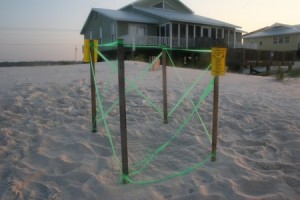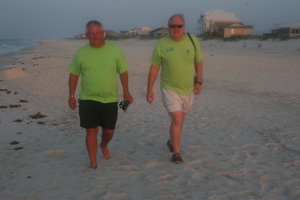 My pal, Lisa Metheny, and I got up before dawn and headed out to Orange Beach last May to meet the Turtle TSar, Mike Reynolds. We were in Alabama, courtesy of the Alabama Gulf Coast CVB, to fish and report about the current state of the Gulf and its waters.
My pal, Lisa Metheny, and I got up before dawn and headed out to Orange Beach last May to meet the Turtle TSar, Mike Reynolds. We were in Alabama, courtesy of the Alabama Gulf Coast CVB, to fish and report about the current state of the Gulf and its waters.
Reynolds pointed to a place in the sand, cordoned off and marked as a sea turtle nest. “There’s 127 eggs in there.” He said we were looking at the first nest of the season. Later in the season, he would know how many eggs were in each nest.
 From May through October, sea turtles come out of the water. You can tell it’s a turtle in the sand, because its tracks look like a tractor wheel. Loggerhead turtles make most of the nests, but an occasional Kemps Ridley comes ashore to lay her eggs. When Metheny and I were there, the Gulf Coast braced itself for the eventual arrival of the oil spill. With predominantly easterly winds at that time, the nearest heavy oil lay 100 miles away.
From May through October, sea turtles come out of the water. You can tell it’s a turtle in the sand, because its tracks look like a tractor wheel. Loggerhead turtles make most of the nests, but an occasional Kemps Ridley comes ashore to lay her eggs. When Metheny and I were there, the Gulf Coast braced itself for the eventual arrival of the oil spill. With predominantly easterly winds at that time, the nearest heavy oil lay 100 miles away.
Reynolds and I kept in touch throughout this summer and he reported that by July 4, volunteers had located 22 nests. Those nests, at that time, would be packed in beach sand in special shipping containers, then driven to Destin, Fla., and shipped by FedEx to Cape Canaveral.
Reynolds, a real estate broker, and his wife, Prissy, moved to Gulf Shores, Ala., in 2001. At that time, he became interested in saving sea turtles from heading in the wrong direction – that is, toward city and condo lights and not back into the sea. He said at that time, only the US Fish & Wildlife Service marked nests. Reynolds became a volunteer to help those efforts and then, helped organize Share the Beach. He now wears a little pin that reads, “Turtle Tsar.”
Reynolds said Share the Beach has grown in ranks to at least 300 volunteers. They patrol the beaches, as they search for new nests and mark them, date them and keep an eye on them. Some volunteers work late-night, nest-sitting duties. Reynolds explained that when it comes time for turtles to hatch, they go toward the light – even the lights across the highway or local beach condos. So, volunteers block artificial light and dig trenches toward the sea. When the babies hatch, they are attracted to the moonlight and ergo, the right direction. “Mama sea turtles get disoriented, too, by light,” said Reynolds.
Reynolds continued, “We couldn’t do this without the volunteers. We have 47 miles of beach in Alabama, just the white sandy beaches. It’s divided into seven sections and each section has a team leader. Almost everybody is local, except this year, we have a new team leader who is the temporary volunteer coordinator – vacationers who want to be part of the training.” These vacationers get basic turtle training that includes a walk on the beach.
Last year, an estimated 4300 hatchlings made it back to the Gulf of Mexico. Overall, the organization estimated it has guided about 17,390 hatchlings from their nests to the water.

Volunteer Tom Spangrud and Turtle Tsar Mike Reynolds on the beach near Gulf Shores. Photo by Barbara Baird.
Beaches continue to be monitored and cleaned daily. Reynolds says donations are appreciated, especially toward a goal to buy three Polaris ATVs to help volunteers move faster, farther.
See www.Alabamaseaturtles.com or call 1-866-SEA-TURTLE.
For information about the beaches along the Gulf: http://www.gulfshores.com/
Publisher/Editor Barbara Baird is a freelance writer in hunting, shooting and outdoor markets. Her bylines are found at several top hunting and shooting publications. She also is a travel writer, and you can follow her at https://www.ozarkian.com. View all posts by Barbara Baird
Hey Barb, I just finished a site inspection in Mobile, AL. I wish now I would have looked for the turtle nests but I’ll make sure to do that next year when I return there. Great article as I never knew the artificial light could confuse the hatchlings…good to know.
Thank you for the story. I would like to know how the turtles continue to fare in the wake of the oil spill…